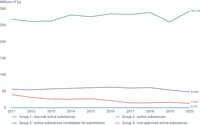
The chart shows the total amount (in kilograms) of active substances sold in the EU-27 annually between 2011 and 2020, by categorisation of active substances. The statistics on quantities of active substances placed on the market in plant protection products are collected under Regulation (EC) No 1107/2009, provided to Eurostat under Annex I of Regulation (EC) No 1185/2009 on statistics on pesticides. These are are also disseminated in the Eurostat dataset ‘Pesticide sales’ (aei_fm_salpest09).Those data are categorised into 4 groups defined in the Annex of Commission Directive (EU) 2019/782.The categorisation of active substances is the same as the one used by the European Commission for the calculation of its harmonised risk indicators. It includes: group 1 - low-risk active substances; group 2 – approved active substances; group 3 - active substances that are candidates for substitution and group 4 - unapproved active substances. Goup 2 includes approved active substances that are neither low-risk nor candidates for substitution, around 75% of all approved active substances in the EU according to the EU Pesticides Database.


Country data from European database on disturbances

Deforestation in the EU-27 as collected by countries for the reporting on forest resources to the United Nations Economic Commission for Europe (UNECE), Food and Agriculture Organization (FAO) and Forest Europe processes

The eight most relevant pressures on forests from forestry activities.

Forest area in the EU-27 as collected by countries for the reporting on forest resources to the UNECE, FAO and Forest Europe processes

The figure shows the annual average population weighted concentration of PM₂.₅ in the poorest quintile (upper line) and richest quintile (lower line) of NUTS3 regions in the EU, as measured by Gross Domestic Product (GDP) per capita at purchasing power standard.

The graph shows the ratio of the annual average population weighted concentration of PM₂.₅ in the poorest quintile divided by that of the richest quintile of NUTS3 regions in the EU, as measured by Gross Domestic Product (GDP) per capita at purchasing power standard, per year.

The figure shows the trend in total emissions of the main air pollutants, indexed as a percentage of their value in the reference year 2005

The figure shows the contributions of the main source sectors to the emissions of key air pollutants in the EU-27 in 2020.